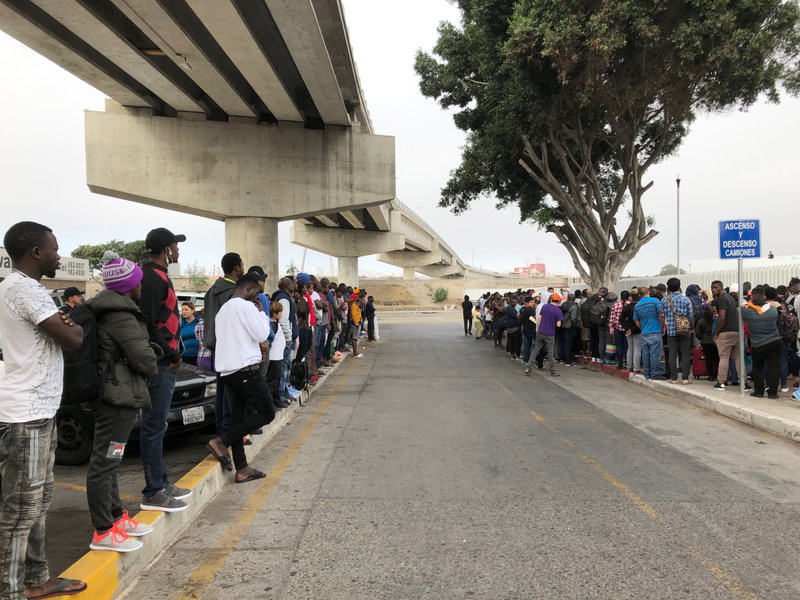TIJUANA, Mexico -- The Cameroonian men who share 10 mattresses on the floor of a third-floor apartment above a barber shop walk every morning to the busiest U.S. border crossing with Mexico, hoping against all odds that it will be their lucky day to claim asylum in the United States. Their unlikely bet is that a sympathetic Mexican official will somehow find a spot for them.
"I go because if they open up, I'm in," said Rashidou Hdzekasaah, 35, who has been idled in Tijuana for two months and still has more than 6,000 names ahead of him on a waiting list to claim asylum at the San Diego crossing.
English-speaking Cameroonians fleeing atrocities of their French-speaking government helped push Tijuana's asylum wait list to 10,000 on Sunday, up from 4,800 just three months earlier. At the same time, the U.S. is returning more Central Americans to Mexico to wait for dates in U.S. immigration court, putting asylum seekers in an unexpected, prolonged period of uncertainty.
Based on Mexican government figures and reporting by The Associated Press, at least 40,000 migrants who have reached the U.S. border with Mexico are on a waiting list for an initial attempt to seek asylum or waiting for a court hearing in the U.S. after being sent back.
The figure represents a dramatic increase from earlier in the year. It is unknown how many have entered the U.S. illegally, decided to settle in Mexico or gone back to Central America.
The long waits are testing the patience of some asylum seekers and residents in border cities.
More than 100 Cameroonians blocked the path of the government immigration vans last month, demanding more transparency about who gets accepted from the wait list to request asylum. It came after several days in which the U.S. accepted no claims. People getting called now have been in Tijuana about 3½ months, but the wait is expected to lengthen.
Mexico, responding to President Donald Trump's threat to raise tariffs, agreed in June to rapid expansion of a new U.S. policy to make asylum seekers wait in Mexico while their cases wind through clogged U.S. courts. The number of people returned nearly doubled over the next month, hitting 19,911 on July 11, according to the Mexican government's latest published figures.
Many others haven't even reached the first step toward asylum. Lines began to swell last year when the Trump administration limited the number of cases it accepts each day for processing, leaving it to Mexican agencies, volunteers, nonprofit organizations and migrants themselves to decide who fills available slots. U.S. authorities say the practice, called "metering," responds to an inability to handle everyone at once.
The waiting list in Ciudad Juarez, across from El Paso, jumped to 5,600 people from 4,500 in early May. The U.S., which has generally processed 20 to 30 claims a day, went six days without accepting anyone on an eight-day stretch in July.
Nuevo Laredo, across from Laredo, Texas, had 1,800 names and Matamoros, across from Brownsville, had 1,500. There were fewer than 1,000 each in San Luis Rio Colorado, near Yuma, Ariz., Reynosa, near McAllen, Texas, and Piedras Negras, near Eagle Pass, Texas, according to advocates and shelter managers.
Tijuana's wait list has skyrocketed in large part because so many Cameroonians are showing up to request asylum. Many of them share personal accounts of Cameroonian soldiers burning their villages, shooting indiscriminately and torturing any perceived opponents.
Beltran Ngi, 33, goes to the Tijuana border crossing to hear someone tick names off the waiting list on a bullhorn around 8 a.m., even though there are more than 8,000 names ahead of him. He is suspicious of asylum seekers who are escorted separately to a waiting Mexican immigration van without having their names called. On a recent Friday, about half of 40 spots were for people whose names weren't called.
He said he fled Cameroon after five days imprisoned in a cell with 40 people who shared one pail as a toilet. Before he was imprisoned, he was visiting an uncle in a neighboring village when soldiers beat his father and set his house on fire.
Ngi, who hopes to join family in North Dakota, followed a route favored by Cameroonians: flying to Ecuador due to loose restrictions on accepting visitors from the African nation and traveling through eight countries. He was famished on his 11-day walk through Panama but reminded himself it was better than Cameroon.
"It's better to die in the jungle than to die of bullets," he told himself.
Information for this article was contributed by Cedar Attanasio, Astrid Galvan, Nomaan Merchant and Maria Verza of The Associated Press.
A Section on 08/09/2019
